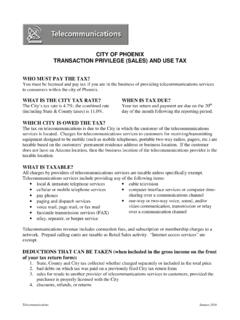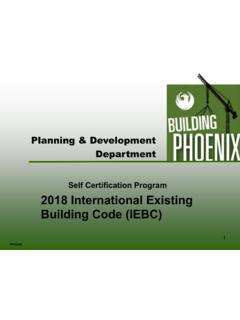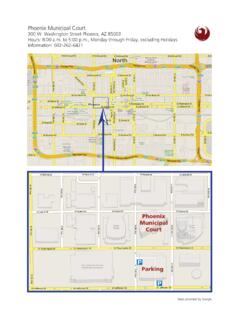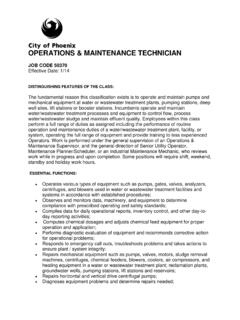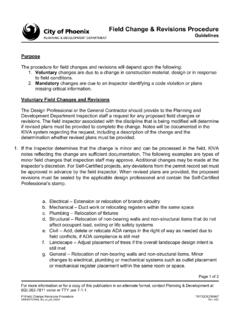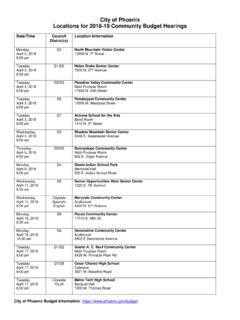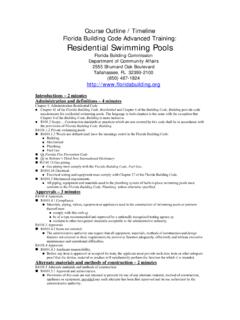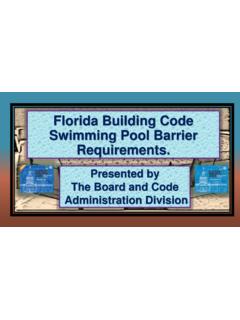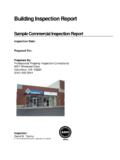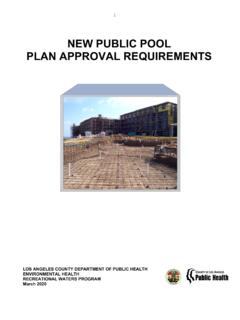Transcription of Pool Barriers Requirement - Phoenix, Arizona
1 Pool Barriers Requirement For more information or for a copy of this publication in an alternate format, contact Planning & Development at (602) 262-7811 voice / (602) 534-5500 TTY. P:\Pool Barriers TRT/DOC/00144 WEB\dsd_trt_pdf_00144 Rev. 7/19 In April 1990, the City Council adopted code changes that strengthen city requirements for enclosure of swimming pools. This publication is intended to inform owners and contractors of the various options available when considering the appropriate barrier between residences and swimming pools located on the same property. Also included are reminders of requirements , so customers are prepared for the inspection process and help assure completion of the pool is not delayed. Two inspections (pre-gunite and pre-plaster) are conducted to ensure swimming pools comply with Phoenix Building Construction Code life/safety provisions. One set of life/safety provisions concern barrier requirements to help prevent accidental drowning.
2 In addition to the fence separating a pool from neighboring properties, three options are available to address the Requirement of providing a physical barrier between a house and a swimming pool located on the same property. One option is to construct an inner barrier fence around the entire pool. Other options include utilizing the residence wall within the pool enclosure as part of the approved barrier or use of a motorized safety cover which complies with ASTM F 1346. Please see the 2018 International swimming Pool and Spa Code (ISPSC) with City of Phoenix Amendments for pool barrier requirements . The following are examples of the requirements : BARRIER FENCE requirements (Inspected during pre-plaster inspection ) The fence must be five feet (5 ) high measured from the exterior side of the fence. There cannot be any holes or openings that would allow a four-inch ball to pass through. Maximum vertical clearance between grade and the bottom of the barrier shall be two inches, measured on the side of the barrier that faces away from the pool, or four inches, when grade is a solid surface, such as concrete.
3 Minimum of 45 inches between horizontal bars, toeholds or handholds to prevent climbing, wire mesh or chain link to provide a maximum opening size of 1 inches measured horizontally. All metallic parts within five feet of the inside wall of the pool shall be bonded with at least 8 AWG wire. Mesh fencing must meet the requirements of ASTM F2286, maximum vertical clearance from grade shall be 1 . GATES (See 2018 ISPSC amended section ) Must be self-closing and self-latching and able to accommodate a lock. Must swing outward from the pool area. Latch must be 54 inches minimum above ground. Must meet same construction requirements as the barrier fence. Non-pedestrian gates over 4 feet wide such as double-gates for vehicles, must meet the requirements of the 2018 ISPSC amended section IF USING HOUSE WALL AS A PART OF A BARRIER An adult must be present during the inspection if belongings or minors are in the home.
4 The house must be open for the inspector to verify the following during pre-plaster inspection : All doors must be self-closing and self-latching and must swing outward from the pool area. A simple latch or lock located a minimum of 54 inches above the floor, or a double-keyed dead bolt at any height is acceptable. Animal or doggie doors are not allowed. (See 2018 ISPSC amended section ) All sliding glass doors including multi panel glass doors, on leaf shall be self-closing and self-latching with an approved automatic door closer or; Provide a separate fence; or Replace the sliding glass door with a self-closing hinged door; or Fasten the door shut with locks or devices that require a tool or key to remove (option not available if this is the only door to the pool area from the room). City of Phoenix Planning & Development Department Pool Barriers Requirement Page 2 of 2 TRT/DOC/00144 Removable pins or locks which prevent the door from opening are not sufficient to meet this safety code.
5 Window latches must be at 54 inches minimum above floor; or Except for bedroom egress windows, screwed in stops (not thumb screws) may be used to limit window openings to four inches; or Except for bedroom egress windows, provide a screwed-in-place wire mesh screen. Windows, where the bottom edge is less than 60 inches above the pool decks and in within five feet of the water s edge, must be tempered glass. Areas outside of windows or doors that otherwise cannot be made to comply with barrier and egress requirements must be fenced. POOL BARRIER requirements FREQENTLY ASKED QUESTIONS ARE OTHER OPTIONS ACCEPTABLE? The code-required minimum barrier must be an automatically closing physical barrier--thus, a self-closing, self-latching door or gate. Other protective devices like temporary fences or alarms do NOT meet these criteria. However, other options are encouraged (not mandated) as an additional layer of protection for small children.
6 These could include: Both self-closing doors and a separate fence Alarms on house doors In-water pool alarms Additional temporary fencing WHEN IS THE INNER YARD BARRIER REQUIRED? With all new swimming pools permitted after May 4, 1990. Whenever an addition or alteration is made to any part of an existing pool enclosure (such as a change to a fence or to the wall of a house), then the new work must comply with the new barrier standards. EXAMPLE: If you change a door to the backyard, the door must be made self-closing if it is part of the barrier. AFTER MAY 4, 1991, a barrier between the house, apartment or hotel room and the pool IS REQUIRED on: All public or semi-public pools such as at apartments, hotels and resorts. All single-family pools where the pool is accessible to children under age six. This means whenever a child resides in the house or regularly visits the property, such as in a day care or baby-sitter situation, or a relative s house.
7 These Barriers are required to be installed retroactively, even if the pool was built before 1991. WHAT IF I DON'T HAVE CHILDREN IN MY HOME OR IF I REMODEL OR BUILD AN ADDITION? If the pool was permitted prior to May 4, 1990, the ordinance provides an exception to require retroactive installation of inner yard Barriers if children under six reside in or regularly visit the home. In this case, the ordinance does not state that the pool owner remains responsible for providing a temporary physical barrier when an occasional child visits the property. Additions and remodels to existing homes that alter or change any part of the pool barrier must meet the provisions of the 2018 ISPSC. WHAT ABOUT A FENCE BUILT BEFORE 1990? For pools permitted prior to May 4, 1990, a grandfather clause allows existing inner yard Barriers to stay in place if they are at least 4 feet high and otherwise meet prior barrier standards.
8 Newly installed fences must always be 5 feet high. IF MY CHILD GROWS UP OR MOVES AWAY, CAN I TAKE DOWN THE BARRIER? NO! The barrier may not be removed! The current standard is intended to eventually apply to all existing pools. The exception is intended to minimize impact on existing pools not currently accessible to small children. WHEN MUST THE BARRIER BE INSTALLED? Immediately for existing pools accessible to small children.
